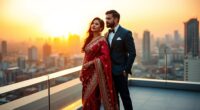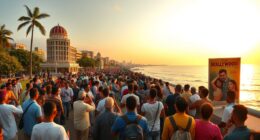India’s Censor Board rates films based on content standards like violence, language, sexual themes, and social values. These ratings help determine who can watch the film and influence how it’s perceived and marketed. They also reflect societal sensitivities and can impact a film’s success. Understanding these standards shows how filmmaking adapts to cultural norms and legal rules. If you explore further, you’ll see how these ratings shape Indian cinema and public conversations.
Key Takeaways
- The CBFC assesses films based on violence, language, sexual content, and social themes to assign appropriate ratings.
- Ratings influence audience eligibility, content edits, and the film’s commercial success and distribution.
- Censorship criteria reflect India’s cultural values, societal norms, and legal standards, shaping film content.
- The criteria evolve with societal changes and often face criticism for overreach or inconsistency.
- Ratings impact public perception, thematic choices, and the overall landscape of Indian cinema.

India’s censor board ratings play a vital role in shaping what audiences see on screen, influencing both filmmakers and viewers. When you watch a film in India, the rating assigned by the Central Board of Film Certification (CBFC) determines not just who can see it, but also how the film’s content is perceived and discussed. This rating system is based on specific censorship criteria, which evaluate elements like violence, language, sexual content, and social themes. These criteria serve as the foundation for the decision-making process, guiding officials in evaluating whether a film aligns with cultural norms and legal standards. As a result, the censorship criteria directly impact the rating a film receives, often leading to cuts, modifications, or even bans if deemed inappropriate. Understanding censorship criteria helps explain how these standards influence film classification decisions.
India’s film ratings are shaped by censorship criteria reflecting cultural norms, affecting content, perception, and audience reach.
The rating impact is significant because it influences a film’s commercial success and its reach to audiences. For filmmakers, understanding how censorship criteria shape ratings means they often tailor their content to meet the board’s standards. This can lead to creative compromises, where certain scenes are edited or toned down to avoid an adult or restricted classification. For viewers, these ratings act as a marker of what to expect, guiding them in choosing films suitable for different age groups. A film rated as “U” (Universal) can be watched by children and families, while an “A” (Adult) rating signals mature content. The rating impact also extends to how films are marketed and distributed, with some movies facing delays or censorship-induced edits that alter their original vision.
You might not realize that the censorship criteria aren’t static; they evolve with societal values and political climates. Sometimes, the CBFC faces criticism for overreach or inconsistency, sparking debates about artistic freedom versus cultural sensitivities. These discussions highlight the delicate balance the board must maintain—protecting cultural norms without stifling creativity. The impact of ratings on a film’s success can be profound, shaping public perception and box office performance. For filmmakers, steering through this landscape means understanding how censorship criteria shape ratings and which themes may trigger restrictions. For audiences, it means being aware of how ratings can influence not only what they see but also how society perceives certain topics.
In essence, India’s censor board ratings are more than just labels; they’re a reflection of the country’s cultural values and societal standards. They shape the film industry’s output and influence public discourse, making them a crucial aspect of Indian cinema’s landscape.
Frequently Asked Questions
How Are Ratings Different for Regional Versus Hindi Films?
You’ll find that ratings for regional language films often consider local cultural nuances, which can differ markedly from Hindi films. The Censor Board assesses content based on cultural sensitivities, language, and regional norms, sometimes leading to different ratings. This means regional films might face stricter scrutiny or more lenient treatment depending on their cultural context, highlighting how local values influence the classification process and impact a film’s reach within diverse audiences.
Do Filmmakers Have Any Influence Over the Rating Decision?
You might wonder if filmmakers can influence their film ratings. While the Censor Board’s decisions are ultimately official, filmmakers often engage in rating lobbying, attempting to sway the board’s judgment. Your influence can be seen in strategic edits or discussions aimed at securing a desired rating. However, the final decision rests with the board, and influence doesn’t guarantee a specific rating, making it a delicate balance for filmmakers.
How Often Are Rating Guidelines Updated or Changed?
You might wonder how often rating guidelines are updated or changed. The film censorship process aims for rating transparency, but updates can be infrequent or inconsistent. The Central Board of Film Certification reviews guidelines periodically, often every few years, though sometimes they shift due to new societal norms or policy changes. These updates impact how filmmakers navigate censorship, emphasizing the importance of staying informed about current standards to avoid surprises or delays.
Are There Appeals Processes for Rating Decisions?
Think of the appeal process as a safety net, catching films that might’ve been unfairly judged. When a rating doesn’t sit well with filmmakers, they can challenge the decision through an appeal. This process considers audience perception and censorship criteria, aiming for fairness. It’s crucial because it guarantees that films aren’t unduly censored, allowing creators to express their vision while respecting societal standards.
How Do Ratings Impact a Film’S Commercial Success?
You’ll find that a film’s rating considerably influences its commercial success by shaping audience perceptions and film marketing strategies. A restrictive censorship impact might limit your film’s reach or target audience, reducing box office potential. Conversely, an approved rating can boost visibility and appeal. Understanding how ratings affect your film helps you tailor marketing efforts and anticipate audience reception, ultimately maximizing your film’s profitability and success in a competitive market.
Conclusion
Understanding how India’s Censor Board rates films helps you see the influence behind what you watch. Did you know that over 1,500 films are reviewed annually, with nearly 10% facing cuts or bans? This shows how strict the system is and why it matters—your viewing choices are shaped by these decisions. Next time you see a film, remember the complex process that determines what’s suitable for Indian audiences.









